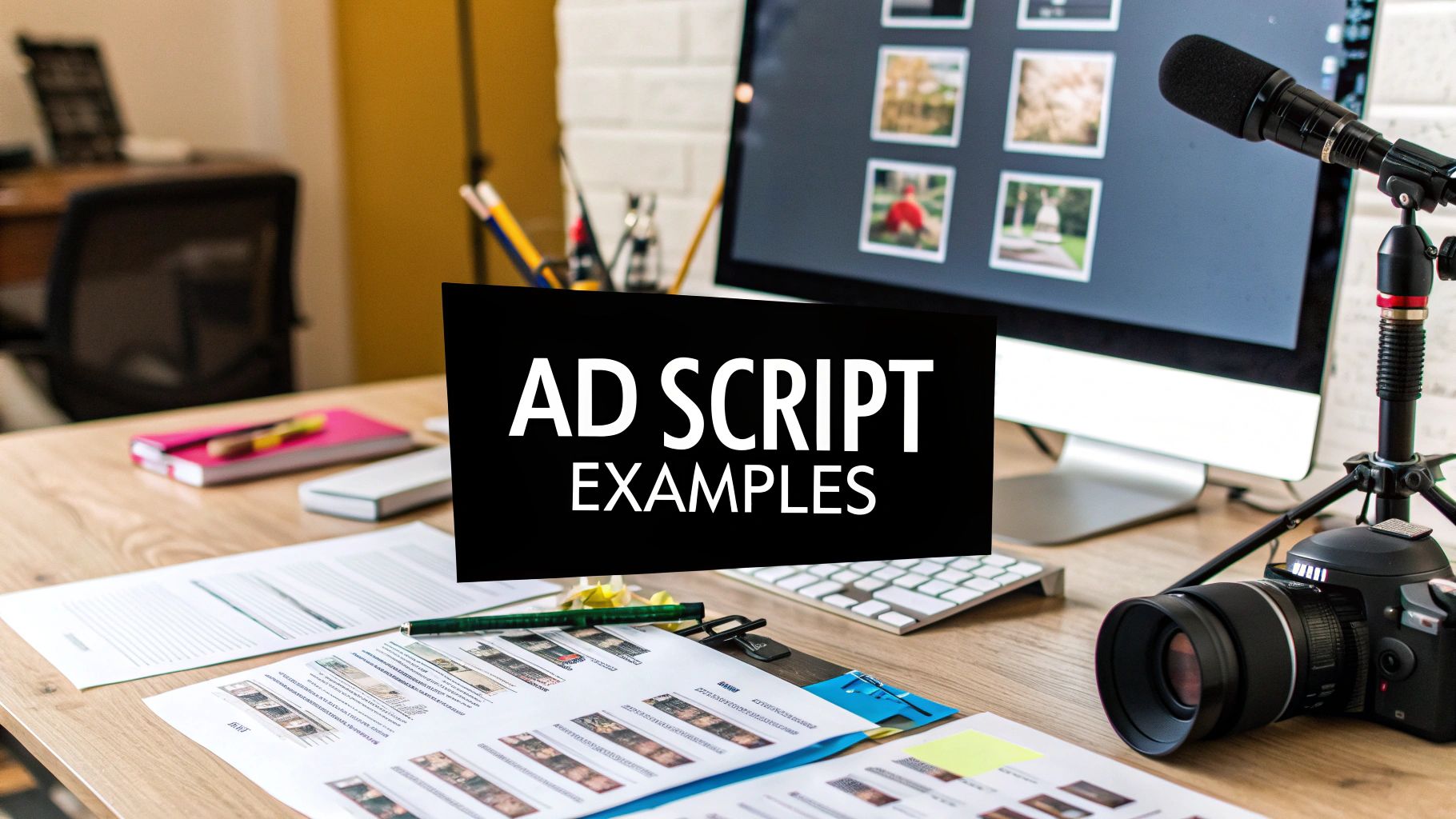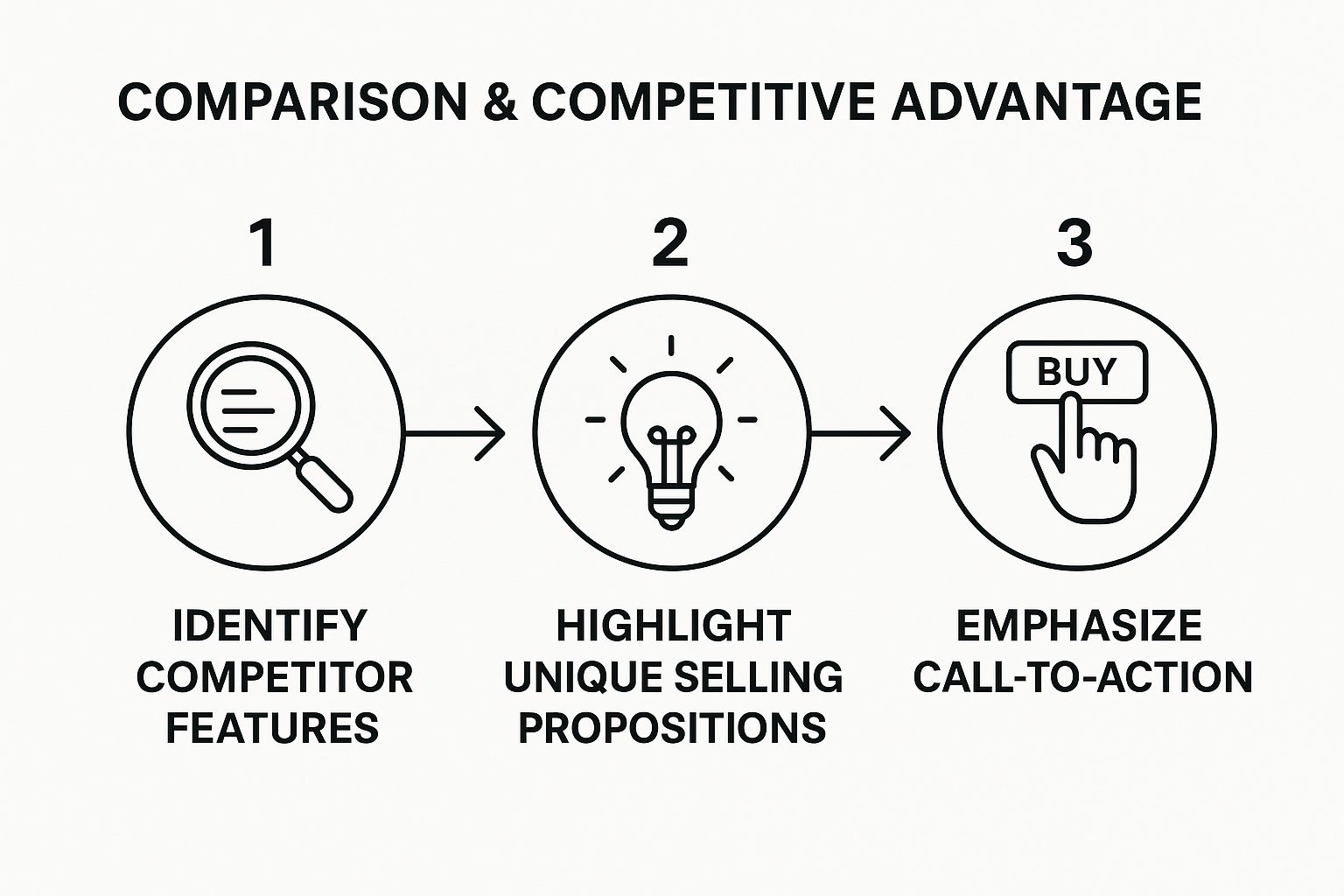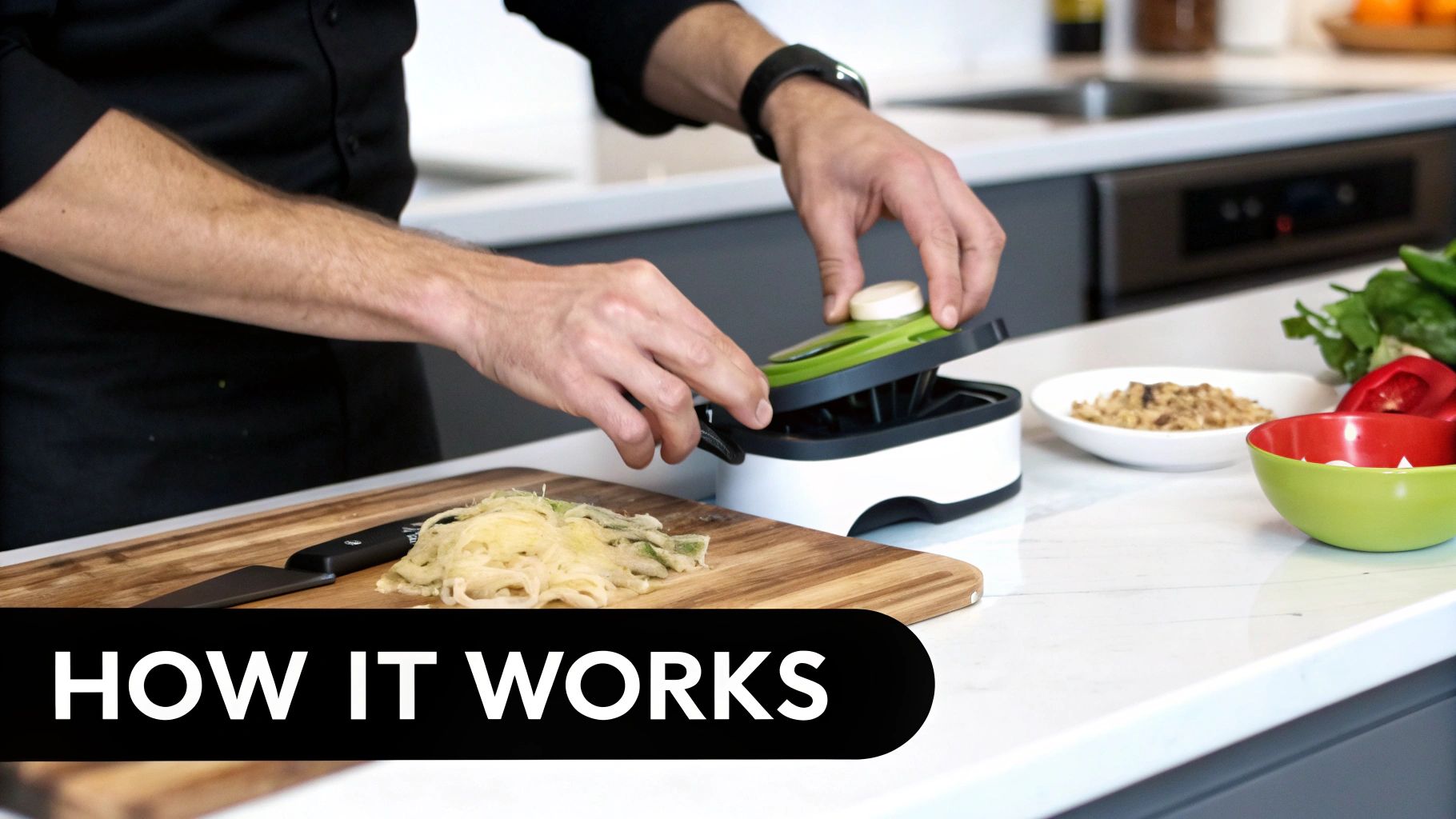
6 Advertisement Script Example Templates to Use in 2025
Discover 6 powerful advertisement script example templates. Our guide breaks down each script with analysis and actionable tips to boost your campaigns.
In a world saturated with content, a compelling advertisement script is the difference between being seen and being remembered. A great script doesn't just sell a product; it tells a story, solves a problem, and builds a powerful connection with your audience. But transforming a blank page into a conversion-driving masterpiece can feel daunting. How do you structure a narrative that grabs attention in the first three seconds and holds it until the final call to action?
This guide provides more than just a list; it offers a strategic breakdown of six essential advertisement script example templates. We'll dissect what makes each one effective, from its psychological triggers to its structural foundation. Understanding how these scripts fit into broader strategies for compelling branded content is crucial for building a cohesive and persuasive brand voice across all your marketing efforts.
You will receive actionable templates you can immediately adapt for your TV commercials, radio spots, or viral social media ads. Whether you're a seasoned marketer or a startup founder, mastering these frameworks will transform your creative process and drive measurable results. Let's dive into the scripts that turn viewers into loyal customers.
1. Problem-Solution-Benefit Script Structure
The Problem-Solution-Benefit (PSB) framework is a cornerstone of persuasive advertising for a simple reason: it mirrors the human decision-making process. It starts by tapping into a viewer's existing pain point, making them feel understood. Then, it introduces a product or service as the clear and direct answer, before finally painting a vivid picture of the positive outcome, or benefit, they will experience. This structure is highly effective because it creates a logical and emotional journey from frustration to relief.

Pioneered by direct response legends like Claude Hopkins and David Ogilvy, this model excels at converting viewers by addressing their immediate needs. It’s a powerful advertisement script example for products that solve a very specific, tangible issue, from headache relief medication to cleaning products like OxiClean that famously tackle impossible stains.
Strategic Breakdown
The power of the PSB model lies in its straightforward psychology.
- Problem: The script opens by agitating a known pain point. This isn't just about stating an issue; it's about using relatable language and visuals to make the audience think, "Yes, that's exactly my problem!"
- Solution: This is the pivot. The product is introduced not just as an option, but as the specifically designed solution to the problem just established. It directly answers the viewer's pain.
- Benefit: This final step goes beyond features. Instead of saying what the product does, it shows what the customer's life will be like after using it. The benefit is the emotional payoff: peace of mind, more free time, a sense of accomplishment, or regained confidence.
Actionable Takeaways & Application
This framework is ideal for video ads, radio spots, and landing page scripts where you have a short amount of time to make a strong impact.
When to Use It:
- You have a product that solves a clear, demonstrable problem.
- Your target audience is actively looking for a solution to a specific issue.
- You want to create a direct and persuasive message for conversion-focused campaigns (e.g., social media ads, infomercials).
How to Apply It:
- Identify a Singular Pain Point: Don't try to solve every problem. Focus your script on the single most frustrating issue your target customer faces.
- Present an Undeniable Link: Ensure your product is presented as the perfect bridge from the problem to the benefit. The connection must feel intuitive and obvious.
- Focus on "After" Scenarios: Use visuals and language to showcase the positive emotional state after the problem is gone. The benefit is the hero of the story. For example, instead of just "cleaner clothes," show a person confidently wearing their perfectly white shirt at an important event.
2. Storytelling Narrative Script
The Storytelling Narrative script moves beyond direct persuasion to forge a deep, emotional connection with the audience. Instead of highlighting features, it weaves a brand into a relatable human story, complete with characters, conflict, and resolution. This framework transforms a product from a simple commodity into a meaningful part of a consumer's life, fostering loyalty that transcends price and features.
This approach is powerful because humans are hardwired for stories. A well-told narrative can bypass cynical ad filters and resonate on a personal level, making the brand message more memorable and impactful. This type of advertisement script example is famously used in campaigns like Google's "Dear Sophie," which tells a father's journey of documenting his daughter's life for her, and nearly every iconic John Lewis Christmas advertisement.
Strategic Breakdown
The strength of a storytelling script lies in its ability to evoke genuine emotion.
- Character & Conflict: The script introduces a relatable protagonist facing a universal human challenge or desire. This could be a young athlete overcoming doubt, a family trying to connect, or an individual striving for self-acceptance. The conflict creates immediate viewer investment.
- Journey & Climax: The narrative follows the character's journey as they navigate the conflict. The brand or product is often introduced subtly, not as a magic solution, but as an enabler or a companion on that journey. The climax is the emotional peak where the character achieves their goal.
- Resolution & Brand Association: The story concludes with a satisfying resolution, leaving the audience with a positive feeling. The brand is then tied to this emotion, creating a powerful association. The viewer remembers the feeling, and by extension, the brand that delivered it.
Actionable Takeaways & Application
This framework is exceptionally effective for brand-building campaigns on television, cinema, and premium digital video platforms where you can capture a viewer's undivided attention.
When to Use It:
- You want to build long-term brand equity and emotional loyalty.
- Your product is part of a lifestyle or aspirational identity (e.g., luxury goods, athletic wear, family-oriented services).
- You aim to differentiate your brand in a crowded market based on values rather than features.
How to Apply It:
- Identify a Core Human Truth: Connect your brand to a universal experience like love, ambition, belonging, or overcoming adversity. Explore these themes in-depth with more brand storytelling examples to find your angle.
- Make the Brand a Supporting Character: The story should be the hero, not the product. The brand should play a natural, supporting role in the protagonist's journey, helping them achieve their goal without being the sole reason for their success.
- Prioritize "Show, Don't Tell": Use strong visuals, music, and character actions to convey emotion rather than relying on dialogue or voiceover. The goal is to make the audience feel the story, not just hear it. A single emotional expression can be more powerful than lines of copy.
3. Testimonial and Social Proof Script
The Testimonial and Social Proof script structure shifts the focus from the brand talking about itself to satisfied customers doing the talking for it. This framework leverages the psychological principle that people trust peers and third-party validation more than direct advertising. It builds credibility by showcasing authentic experiences, reducing buyer skepticism and providing relatable proof that the product or service delivers on its promises.

This method was popularized by direct response marketers and has become a staple for e-commerce, SaaS, and health and wellness brands. It’s the driving force behind compelling advertisement script example campaigns from brands like Weight Watchers, which features member success stories, and countless software companies that use detailed case studies to demonstrate ROI. The goal is to let a real person's success story become the most persuasive sales pitch.
Strategic Breakdown
The power of this script lies in its authenticity and relatability.
- Relatability: The script introduces a real person who embodies the target customer's demographic, challenges, and aspirations. The audience sees themselves in the storyteller, creating an immediate connection.
- Transformation: The customer narrates their "before" state (the problem), how they used the product (the solution), and their "after" state (the benefit). This journey provides a credible, human-centered version of the Problem-Solution-Benefit framework.
- Validation: By featuring specific results, metrics, or emotional outcomes, the testimonial provides tangible proof that is far more convincing than a brand's own claims. It answers the viewer's core question: "Will this work for someone like me?"
Actionable Takeaways & Application
This framework is exceptionally effective for video ads on social media, landing pages, and website homepages where building trust is paramount. You can explore a variety of powerful video testimonial examples here to see this strategy in action.
When to Use It:
- Your product has a track record of producing measurable or visually demonstrable results.
- You operate in a high-skepticism market (e.g., finance, health, online courses).
- Your goal is to build community and foster brand loyalty by showcasing real users.
How to Apply It:
- Source Diverse Stories: Don't just feature one type of customer. Collect testimonials from a range of users to show broad appeal and allow different audience segments to find someone they relate to.
- Guide, Don't Script: To maintain authenticity, provide your customers with guiding questions (e.g., "What was your biggest challenge before?" or "What specific result surprised you the most?") rather than a rigid script.
- Show, Don't Just Tell: Whenever possible, pair the testimonial with visual proof. This could be before-and-after photos for a beauty product, a screen recording of software results, or a clip of a customer enjoying the benefits of your service. The visual evidence amplifies the spoken word.
4. Comparison and Competitive Advantage Script
The Comparison and Competitive Advantage script operates on a bold and direct principle: showing customers exactly why your product is the superior choice. This framework directly pits a brand against its competitors, either explicitly by name or implicitly against a generic "other brand." It works by isolating a key area of differentiation, such as features, price, or performance, and using that to create a compelling argument for its own superiority.

This method was famously used in the iconic "Mac vs. PC" campaigns and the "Pepsi Challenge," forever changing the landscape of advertising. This type of advertisement script example is incredibly effective for challenger brands trying to disrupt a market or for established leaders reinforcing their dominance. It cuts through the noise by providing a clear, logical reason to choose one product over another.
Strategic Breakdown
The strength of this script lies in its ability to reframe the customer's buying decision.
- Establish a Benchmark: The script begins by setting up a comparison, often using a competitor's well-known weakness or a common industry standard as the benchmark.
- Introduce Superiority: It then presents the product’s unique selling proposition (USP) as the direct and better alternative to that benchmark. This is where a key feature or benefit is highlighted.
- Demonstrate the Advantage: The final part of the script provides proof. This can be a visual demonstration, customer testimonials, or hard data that validates the claim of superiority and shows the tangible benefit to the consumer.
Actionable Takeaways & Application
This framework is a powerful choice for TV commercials, online video ads, and print media where a side-by-side comparison can be visually represented.
When to Use It:
- You have a clear, demonstrable advantage over competitors (e.g., faster, more durable, easier to use).
- You are in a crowded market and need to clearly differentiate your brand.
- Your target audience is analytical and responds well to data-driven or feature-focused arguments.
How to Apply It:
- Isolate a Meaningful Differentiator: Don't compare every feature. Focus on the one or two advantages that matter most to your target customer and are difficult for competitors to replicate.
- Ensure Defensibility: All claims must be factually accurate and legally defensible. Vague claims are ineffective, and false claims can lead to legal trouble. Use objective, measurable criteria whenever possible.
- Frame it Positively: Instead of just attacking the competition, frame the script around the positive benefits the customer gains by choosing your product. The goal is to elevate your brand, not just tear another down.
5. Demonstration and How-It-Works Script
The Demonstration or "How-It-Works" script is built on the simple yet powerful principle: showing is more persuasive than telling. This format focuses on providing clear, undeniable visual proof of a product's value. It walks the audience through how the product functions, often using compelling before-and-after scenarios to highlight its effectiveness and tangible results. This approach builds trust by letting the product's performance speak for itself.

Popularized by the infomercial industry and home shopping networks like QVC, this model is a masterclass in converting skepticism into desire. It's an incredibly effective advertisement script example for any product with a visually demonstrable result, from kitchen gadgets like the Vitamix blender that pulverizes anything to cleaning products like Scrub Daddy that tackle tough grime in seconds. The visual evidence removes doubt and makes the product's benefits feel concrete and achievable.
Strategic Breakdown
The power of the demonstration script lies in its ability to educate and persuade simultaneously.
- The Setup: The script begins by presenting a common, relatable problem. This could be a stubborn stain, a tedious cooking task, or an inefficient workout. The scene is set to make the coming demonstration highly relevant.
- The Demonstration: This is the core of the script. The product is introduced and used in real-time to solve the established problem. The focus is on clarity, showing each step of how the product works and highlighting its unique features in action.
- The Payoff: The script concludes with the "ta-da" moment: the dramatic reveal of the result. This is often a powerful before-and-after shot that provides irrefutable proof of the product's efficacy, leaving the viewer impressed and convinced.
Actionable Takeaways & Application
This framework is perfectly suited for video-centric platforms like YouTube, TikTok, and Instagram, as well as for product landing pages and TV commercials. To gain a deeper understanding of visual storytelling in ads, you can learn more about how to create commercials.
When to Use It:
- Your product has a unique mechanism or a visually impressive result.
- You need to overcome customer skepticism about your product's claims.
- Your target audience values practical benefits and tangible proof (e.g., homeowners, tech users, fitness enthusiasts).
How to Apply It:
- Isolate the "Wow" Factor: Identify the single most impressive feature or result your product delivers. Build the entire demonstration around showcasing this key benefit.
- Keep it Simple and Clear: Avoid overly complex demonstrations. The process should look easy and repeatable for the average viewer, empowering them to achieve the same results.
- Emphasize the "Before and After": Use split screens, quick cuts, or time-lapses to create a stark contrast between the problem state and the solution state. The visual transformation is your most powerful selling tool. For a software demo, this could be showing a cluttered, inefficient workflow transformed into a streamlined, one-click process.
6. Emotional Appeal and Lifestyle Script
The Emotional Appeal and Lifestyle script sells a feeling, not a feature. Instead of focusing on what a product does, it connects with the audience's aspirations, values, and desired identity. It works by creating a powerful emotional association between the brand and a specific lifestyle, making the product a key to unlocking that experience. This approach is less about direct persuasion and more about creating an aspirational narrative the viewer wants to be part of.
This method has been mastered by luxury, fashion, and travel brands that understand their customers are buying into an identity. Think of a premium car commercial that shows the vehicle cruising along a scenic coast, or a perfume ad that focuses on romance and confidence rather than its ingredients. This type of advertisement script example is about crafting a world and inviting the consumer to join.
Strategic Breakdown
The strength of this model is its ability to build a deep, lasting brand connection that transcends product specs.
- Emotion: The script’s primary goal is to evoke a specific feeling: joy, freedom, sophistication, security, or belonging. This is achieved through carefully chosen music, visuals, pacing, and sparse, evocative language.
- Aspiration: It taps into the viewer’s ideal self. The characters and scenarios in the ad represent who the target audience wants to be or what they wish to experience. The product is presented as an integral part of that aspirational life.
- Subtle Integration: The product is often not the central focus. It is a natural, almost seamless part of the scene. The goal is to make the product feel like an authentic component of the desired lifestyle, not a forced sales pitch.
Actionable Takeaways & Application
This framework is exceptionally powerful for building brand equity and creating a loyal customer base. It excels in video formats where storytelling can be fully realized.
When to Use It:
- You are building a premium or lifestyle brand where image is paramount.
- Your product's benefits are more emotional and experiential than functional.
- You aim to create long-term brand loyalty rather than a quick, transactional sale.
- Your target audience makes purchasing decisions based on identity and values.
How to Apply It:
- Define the Core Emotion: Pinpoint the single most important feeling you want your brand to own. Is it adventure? Serenity? Confidence? Build the entire script around evoking this one emotion.
- Tell a Human Story: Focus on characters and a narrative, not the product. The story should be relatable and aspirational to your target demographic, making them feel seen and understood.
- Prioritize Cinematography and Sound: High-quality visuals and a compelling soundtrack are non-negotiable. These elements do most of the emotional work, creating the mood and tone that words alone cannot. The product should look like it belongs in this beautiful world you've created.
6 Advertisement Script Styles Comparison
| Script Type | Implementation Complexity 🔄 | Resource Requirements ⚡ | Expected Outcomes 📊 | Ideal Use Cases 💡 | Key Advantages ⭐ | |------------------------------------|---------------------------------------|-----------------------------------|------------------------------------|-------------------------------------------------|---------------------------------------| | Problem-Solution-Benefit Script | Low to Medium - simple 3-part structure | Low - adaptable to many media | High - proven conversion effectiveness | Products solving specific problems, B2C services, direct response campaigns | Highly relatable; clear value proposition; creates urgency | | Storytelling Narrative Script | High - requires narrative & production | High - quality production needed | Medium to High - deep emotional connection and brand building | Brand building, lifestyle products, emotional purchases | Memorable, shareable; strong brand personality; differentiates brand | | Testimonial and Social Proof Script| Low to Medium - depends on testimonial gathering | Low to Medium - minimal production | Medium - builds credibility and trust | Service-based businesses, high-consideration purchases, B2B marketing | Builds immediate trust; authentic validation; cost-effective | | Comparison and Competitive Advantage Script| Medium - requires accuracy and legal review | Medium - research and legal vetting | Medium to High - positions brand competitively | Competitive markets, premium products, feature-rich offerings | Clearly differentiates from competitors; educates consumers | | Demonstration and How-It-Works Script| Medium to High - needs clear demo planning | Medium to High - quality visuals and product reliability | High - educates and builds confidence | Functional products, complex services, innovative features | Concrete proof of claims; reduces purchase regret; educates users | | Emotional Appeal and Lifestyle Script| Medium - needs deep insight into audience | Medium - high-quality visuals/storytelling | Medium to High - builds strong brand loyalty, premium pricing | Luxury products, lifestyle brands, emotional purchase categories | Strong emotional connection; commands premium pricing; brand loyalty |
From Script to Screen: Putting Your Ad Frameworks into Action
You've just explored a powerful arsenal of six distinct advertisement script frameworks, from the direct punch of the Problem-Solution-Benefit model to the deep emotional resonance of a Storytelling Narrative. The journey from a blank page to a compelling ad is no longer a mystery. We've deconstructed each advertisement script example to reveal the underlying psychology and strategic architecture that makes it effective.
The true takeaway is that there is no single "best" script. Success lies in strategic selection. The framework you choose must align perfectly with your campaign's objective, your target audience's mindset, and the platform where your ad will live.
Key Insights and Actionable Next Steps
Mastering these templates requires moving from passive knowledge to active application. Here’s how to translate these frameworks into tangible results:
- Match the Framework to the Goal: Before writing a single word, define your primary objective. Are you driving immediate sales? The Comparison or Demonstration script is your ally. Building brand loyalty? A Storytelling or Emotional Appeal script will create a lasting connection.
- Adapt, Don't Just Copy: These templates are blueprints, not rigid rules. Infuse your brand’s unique voice, personality, and specific customer pain points into every line. A generic script feels inauthentic; a tailored one feels like a conversation.
- Embrace A/B Testing: Don't guess which hook or call to action works best. Draft two variations of a script, perhaps a direct Problem-Solution-Benefit version against a more subtle Emotional Appeal, and let the data tell you what resonates with your audience.
- Analyze Real-World Applications: To see how these structures perform in a competitive marketplace, exploring real-world examples can be incredibly insightful. Studying a curated collection of successful Amazon video ad examples can provide a masterclass in how different script types are adapted for specific products and platforms, revealing patterns you can apply to your own campaigns.
The Power of a Solid Foundation
Ultimately, a well-structured script is the foundation upon which every other element of your advertisement is built, from visuals and sound design to editing pace. It ensures your message is clear, persuasive, and, most importantly, memorable. By understanding and implementing the diverse approaches we've covered, you are no longer just creating ads; you are engineering strategic communication designed to capture attention and inspire action.
Your next great campaign begins with a single, well-chosen framework. Select the one that best fits your immediate needs, customize it with your brand's unique flair, and start creating with the confidence that your message is built on a foundation of proven persuasion.
Ready to bring your scripts to life faster than ever? ViewPrinter uses AI to help you draft compelling ad copy from these proven frameworks, generate custom UGC-style videos with AI avatars, and produce high-converting content in minutes. Stop staring at a blank page and start creating your next winning ad today with ViewPrinter.